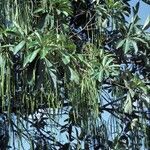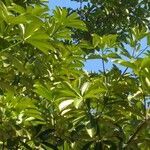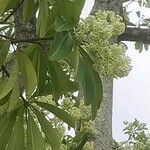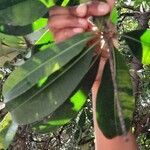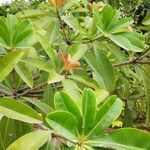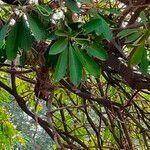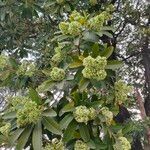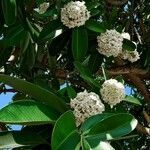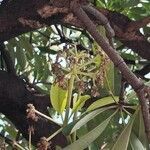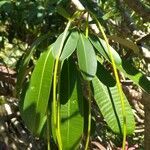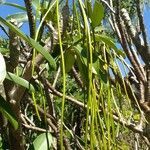| Therapeutic use
|
Abdominal neoplasms (bark), Abdominal pain (bark), Abscess (bark), Anthelmintics (bark), Anti-bacterial agents (bark), Antidepressive agents (bark), Anti-infective agents (bark), Anti-inflammatory agents (bark), Antineoplastic agents (bark), Antipruritics (bark), Antipyretics (bark), Antirheumatic agents (bark), Appetite stimulants (bark), Arthralgia (bark), Asthenia (bark), Asthma (bark), Astringents (bark), Bronchitis (bark), Cardiotonic agents (bark), Cardiovascular system (bark), Colic (bark), Diarrhea (bark), Dysentery (bark), Dyspepsia (bark), Ear diseases (bark), Fever (bark), Filariasis (bark), Galactogogues (bark), Heart diseases (bark), Helminthiasis (bark), Hypophosphatemia, familial (bark), Hypotension (bark), Lactation disorders (bark), Leishmaniasis (bark), Leprosy (bark), Leukorrhea (bark), Malaria (bark), Neoplasms (bark), Pain (bark), Parasympatholytics (bark), Pneumonia (bark), Postnatal care (bark), General tonic for rejuvenation (bark), Skin diseases (bark), Snake bites (bark), Tuberculosis (bark), Ulcer (bark), Urticaria (bark), Vitiligo (bark), Wounds and injuries (bark), Antiperiodic (bark), Depurative (bark), Antidepressive agents (flower), Anthelmintics (fruit), Epilepsy (fruit), Mental disorders (fruit), General tonic for rejuvenation (fruit), Syphilis (fruit), Antiperiodic (fruit), Anti-infective agents (leaf), Antiviral agents (leaf), Beriberi (leaf), Diarrhea (leaf), Dysentery (leaf), Edema (leaf), Fever (leaf), Hypotension (leaf), Malaria (leaf), Skin diseases (leaf), Snake bites (leaf), Tuberculosis (leaf), Ulcer (leaf), Urticaria (leaf), Wounds and injuries (leaf), Abdominal pain (plant exudate), Antineoplastic agents (plant exudate), Antirheumatic agents (plant exudate), Cough (plant exudate), Earache (plant exudate), Disorder of ejaculation (plant exudate), Gonorrhea (plant exudate), Neoplasms (plant exudate), Toothache (plant exudate), Ulcer (plant exudate), Wounds and injuries (plant exudate), Anthelmintics (rhizome), Antineoplastic agents (root), Appetite stimulants (root), Leukorrhea (root), Liver diseases (root), Stomach diseases (root), Earache (stem), Leukorrhea (stem), Headache (unspecified), Ache(Leg) (unspecified), Antidote(Antiaris) (unspecified), Asthma (unspecified), Astringent (unspecified), Beriberi (unspecified), Boil (unspecified), Cancer (unspecified), Cholera (unspecified), Cough (unspecified), Diabetes (unspecified), Diarrhea (unspecified), Dyschezia (unspecified), Dysentery (unspecified), Enterosis (unspecified), Expectorant (unspecified), Fever (unspecified), Hemiplegia (unspecified), Internal (unspecified), Malaria (unspecified), Nausea (unspecified), Neuralgia (unspecified), Phthisis (unspecified), Piles (unspecified), Pneumonia (unspecified), Poison(Arrow) (unspecified), Rheumatism (unspecified), Stomachic (unspecified), Tonic (unspecified), Toothache (unspecified), Tumor (unspecified), Vermifuge (unspecified), Bronchitis (unspecified), Aphrodisiac (unspecified), Ache(Loin) (unspecified), Alterative (unspecified), Dyslactation (unspecified), Hepatosis (unspecified), Panacea (unspecified), Parturition (unspecified), Pleurisy (unspecified), Tumor(Glands) (unspecified), Abdominal pain (unspecified), Antineoplastic agents (unspecified), Antirheumatic agents (unspecified), Dyspnea (unspecified), Ear diseases (unspecified), Fractures, bone (unspecified), Gastrointestinal diseases (unspecified), Hemophilia a (unspecified), Hypnotics and sedatives (unspecified), Lactation disorders (unspecified), Liver diseases (unspecified), Neoplasms (unspecified), Pain (unspecified), General tonic for rejuvenation (unspecified), Skin diseases (unspecified), Tuberculosis, pulmonary (unspecified), Ulcer (unspecified), Wounds and injuries (unspecified), Antirheumatic agents (wood), Wounds and injuries (wood)
|
